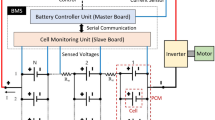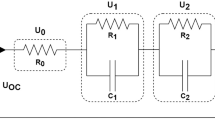Abstract
Accurate state-of-power (SOP) estimation is critical for building battery systems with optimized performance and longer life in electric vehicles and hybrid electric vehicles. This paper proposes a novel parameter identification method and its implementation on SOP prediction for lithium-ion batteries. The extremum seeking algorithm is developed for identifying the parameters of batteries on the basis of an electrical circuit model incorporating hysteresis effect. A rigorous convergence proof of the estimation algorithm is provided. In addition, based on the electrical circuit model with the identified parameters, a battery SOP prediction algorithm is derived, which considers both the voltage and current limitations of the battery. Simulation results for lithium-ion batteries based on real test data from urban dynamometer driving schedule (UDDS) are provided to validate the proposed parameter identification and SOP prediction methods. The proposed method is suitable for real operation of embedded battery management system due to its low complexity and numerical stability.
Similar content being viewed by others
References
V. Minh and J. Pumwa, “Simulation and control of hybrid electric vehicles,” International Journal of Control, Automation and Systems, vol. 10,no. 2, pp. 308–316, April 2012.
S. Han, H. Aki, S. Han, B. Kwon, and J. Park, “Optimal charging strategy for a residential PEV battery considering bidirectional trade and frequency regulation,” International Journal of Control, Automation and Systems, vol. 14,no. 2, pp. 587–597, April 2016.
J. Cao and B. Cao, “Neural network sliding mode control based on on-line identification for electric vehicle with ultracapacitor-battery hybrid power,” International Journal of Control, Automation and Systems, vol. 7,no. 3, pp. 409–418, June 2009.
R. Wongsathan and A. Nuangnit, “Optimal hybrid neurofuzzy based controller using MOGA for photovoltaic (PV) battery charging system,” International Journal of Control, Automation and Systems, vol. 16,no. 6, pp. 3036–3046, December 2018.
G. Plett, “Extended Kalman filtering for battery management systems of LiPB-based HEV battery packs - Part 3. State and parameter estimation,” J. Power Sources, vol. 134,no. 2, pp. 262–276, August 2004.
G. Plett, “Sigma-point Kalman filtering for battery management systems of LiPB-based HEV battery packs: Part 2. Simultaneous state and parameter estimation,” J. Power Sources, vol. 161,no. 2, pp. 1369–1384, October 2006.
Z. Chen, Y. Fu, and C. Mi, “State of charge estimation of lithium-ion batteries in electric drive vehicles using extended Kalman filtering,” IEEE Trans. Vehicular Technology, vol. 62,no. 3, pp. 1020–1030, March 2013.
J. D. Rubio, “Stable Kalman filter and neural network for the chaotic systems identification,” Journal of the Franklin Institute, vol. 354,no. 16, pp. 7444–7462, November 2017.
E. Lughofer, S. Kindermann, M. Pratama, and J. D. Rubio, “Top-down sparse fuzzy regression modeling from data with improved coverage,” International Journal of Fuzzy Systems, vol. 19,no. 5, pp. 1645–1658, October 2017.
J. D. Rubio, E. Lughofer, J. A. Meda-Campana, L. A. Paramo, J. F. Novoa, and J. Pacheco, “Neural network updating via argument Kalman filter for modeling of Takagi-Sugeno fuzzy models,” Journal of Intelligent & Fuzzy Systems, vol. 35,no. 2, pp. 2585–2596, 2018.
J. D. Rubio, E. Lughofer, P. Angelov, and J. Novoa, “A novel algorithm for the modeling of complex processes,” Kybernetika, vol. 54,no. 1, pp. 79–95, 2018.
G. Giordano, V. Klass, M. Behm, G. Lindbergh, and J. Sjoberg, “Model-based lithium-ion battery resistance estimation from electric vehicle operating data,” IEEE Trans. Vehicular Technology, vol. 67,no. 5, pp. 3720–3728, May 2018.
M. Roscher, O. Bohlen, and D. Sauer, “Reliable state estimation of multicell lithium-ion battery system,” IEEE Trans. Energy Conv., vol. 26,no. 3, pp. 737–743, September 2011.
C. Gould, C. Bingham, D. Stone, and P. Bentley, “New battery model and state-of-health determination through subspace parameter estimation and state-observer techniques,” IEEE Trans. Vehicular Technology, vol. 58,no. 8, pp. 3905–3916, October 2009.
A. Fotouhi, D. Auger, K. Propp, and S. Longo, “Electric vehicle battery parameter identification and SOC observability analysis: NiMH and Li-S case studies,” IET Power Electron., vol. 10,no. 11, pp. 1289–1297, September 2017.
X. Chen, W. Shen, M. Dai, Z. Cao, J. Jin, and A. Kapoor, “Robust adaptive sliding-mode observer using RBF neural network for lithium-ion battery state of charge estimation in electric vehicle,” IEEE Trans. Vehicular Technology, vol. 65,no. 4, pp. 1936–1947, April 2016.
Y. Zhang, C. Zhang, and X. Zhang, “State-of-charge estimation of the lithium-ion battery system with time-varying parameter for hybrid electric vehicles,” IET Control Theory Appl., vol. 8,no. 3, pp. 160–167, Feburary 2014.
W. Shen and H. Li, “A sensitivity-based group-wise parameter identification algorithm for the electric model of li-ion battery,” IEEE Access, vol. 8, pp. 4377–4387, March 2017.
T. Feng, L. Yang, X. Zhao, H. Zhang, and J. Qiang, “Online identification of lithium-ion battery parameters based on an improved equivalent-circuit model and its implementation on battery state-of-power prediction,” J. Power Sources, vol. 281, pp. 192–203, May 2015.
F. Sun, R. Xiong, H. He, W. Li, and J. Aussems, “Modelbased dynamic multi-parameter method for peak power estimation of lithium-ion batteries,” Applied Energy, vol. 96, pp. 378–386, August 2012.
R. Xiong, H. He, F. Sun, X. Liu, and Z. Liu, “Model-based state-of-charge and peak power capability joint estimation for lithium-ion battery in plug-in hybrid electric vehicles,” J. Power Sources, vol. 229, pp. 159–169, May 2013.
P. Malysz, J. Ye, R. Gu, H. Yang, and A. Emadi, “Battery state-of-power peak current calculation and verification using an asymmetric parameter equivalent circuit model,” IEEE Trans. Vehicular Technology, vol. 65,no. 6, pp. 4512–4522, June 2016.
J. Lu, Z. Chen, Y. Yang, and M. Lv, “Online estimation of state of power for lithium-ion batteries in electric vehicles using genetic algorithm,” IEEE Access, vol. 6, pp. 20868–20880, April 2018.
M. Benosman and G. Atinc, “Multi-parametric extremum seeking-based learning control for electromagnetic actuators,” International Journal of Control, vol. 88,no. 3, pp. 517–530, April 2015.
M. Benosman, Learning-based Adaptive Control: An Extremum Seeking Approach, Theory and Applications, Elsevier, July 2016.
M. Krstic, “Performance improvement and limitations in extremum seeking control,” Systems & Control Letters, vol. 39, pp. 313–326, April 2000.
M. Rotea, “Analysis of multivariable extremum seeking algorithms,” Proc. American Control Conf., Chicago, USA, pp. 433–437, June 2000.
T. Kim and W. Qiao, “A hybrid battery model capable of capturing dynamic circuit characteristics and nonlinear capacity effects,” IEEE Trans. Energy Conv., vol. 26,no. 4, pp. 1172–1180, December 2011.
M. Verbrugge and E. Tate, “Adaptive state of charge algorithm for nickel metal hydride batteries including hysteresis phenomena,” J. Power Sources, vol. 126, pp. 236–249, Feburary 2004.
T. Kim, Y. Wang, H. Fang, Z. Sahinoglu, and T. Wada, “Model-based condition monitoring for lithium-ion batteries,” J. Power Sources, vol. 295, pp. 16–27, November 2015.
Y. Pan and H. Yu, “Composite learning from adaptive dynamic surface control,” IEEE Trans. Automatic Control, vol. 61,no. 9, pp. 2603–2609, September 2016.
M. Benosman, “Multi-parametric extremum seeking-based auto-tuning for robust input-output linearization control,” International Journal of Robust and Nonlinear Control, vol. 26,no. 18, pp. 4035–4055, 2016.
Y. Tan, D. Nesic, and I. Mareels, “On the choice of dither in extremum seeking systems: a case study,” Automatica, vol. 44,no. 5, pp. 1446–1450, May 2008.
Author information
Authors and Affiliations
Corresponding author
Additional information
Publisher’s Note Springer Nature remains neutral with regard to jurisdictional claims in published maps and institutional affiliations.
Recommended by Associate Editor Yongping Pan under the direction of Editor Young IL Lee. This work is supported by the National Natural Science Foundation of China under Grants No.51807179 and No.51777193, and The Key Research and Development Program of Zhejiang Provience under Grants No.2019C01149.
Chun Wei received his B.S. degree in electrical engineering from Beijing Jiao-tong University, Beijing, China, in 2009, an M.S. degree in electrical engineering from North China Electric Power University, Beijing, China, in 2012, and a Ph.D. degree in electrical engineering from the University of Nebraska-Lincoln, Lincoln, NE, USA, in 2016. He was a postdoctoral researcher in ABB Corporate Research Center, Raleigh, NC, USA in year 2017. He is currently an Associate Professor with College of Information Engineering, Zhejiang University of Technology, Hangzhou, Zhejiang, China. His research interests include renewable energy generation systems, adaptive control, motor drives, and system identification.
Mouhacine Benosman is a Senior Research Scientist at Mitsubishi Electric Research Labs (MERL) in Cambridge, USA. Before joining MERL, he worked at Reims University, France, Strathclyde University, Scotland, and National University of Singapore. His research interests include modeling and control of flexible systems, nonlinear robust and fault tolerant control, multi-agent distributed control with applications to robotics and smart-grid systems, and learning and adaptive control for nonlinear systems. Mouhacine has published a monograph about learning-based adaptive control, more than 100 peer-reviewed journal articles and conference papers, and more than 20 patents in the field of mechatronics systems control. He is a senior member of the IEEE, Associate Editor of the Control System Society Conference Editorial Board, Associate Editor of the Journal of Optimization Theory and Applications, and Senior Editor of the International Journal of Adaptive Control and Signal Processing.
Taesic Kim received his M.S. degree in Electrical Engineering and his Ph.D. degree in Computer Engineering at the University of Nebraska-Lincoln, in 2012 and 2015, respectively. In 2009, He was with the New and Renewable Energy Research Group of Korea Electrotechnology Research Institute, Korea. He was also with Mitsubishi Electric Research Laboratories, Cambridge, MA, USA in 2013. Currently, He is an assistant professor in the Department of Electrical Engineering and Computer Science at the Texas A&M University-Kingsville. He research focuses on energy IoT, power electronics, cyber and physical security, blockchain, and intelligence algorithms for power and energy systems. He holds 2 U.S. patents and co-authored more than 40 papers in refereed journals and IEEE conference proceedings in the field of cyber-physical power and energy systems. He is a Cyber Physical Security Steering Committee for IEEE PELS and a Guest Associate Editor of the IEEE Journal of Emerging and Selective Topics in Power Electronics.
Rights and permissions
About this article
Cite this article
Wei, C., Benosman, M. & Kim, T. Online Parameter Identification for State of Power Prediction of Lithium-ion Batteries in Electric Vehicles Using Extremum Seeking. Int. J. Control Autom. Syst. 17, 2906–2916 (2019). https://doi.org/10.1007/s12555-018-0506-y
Received:
Revised:
Accepted:
Published:
Issue Date:
DOI: https://doi.org/10.1007/s12555-018-0506-y




